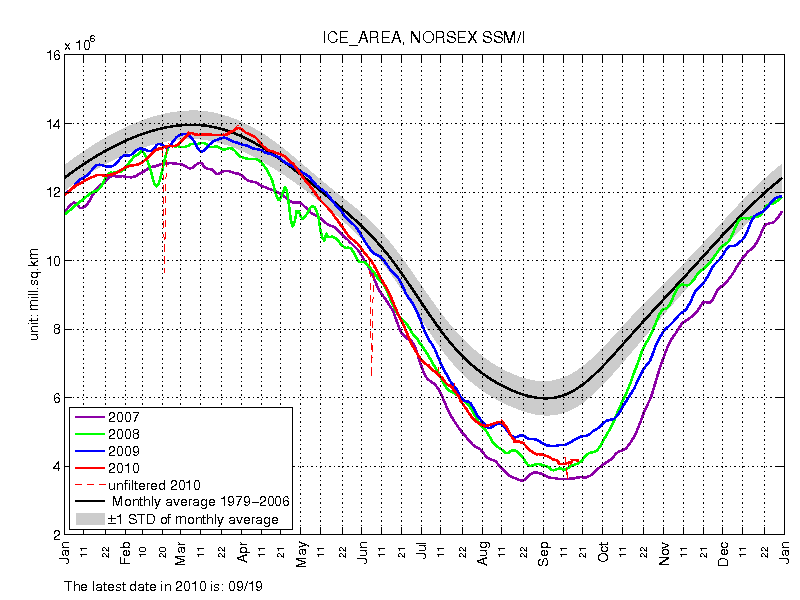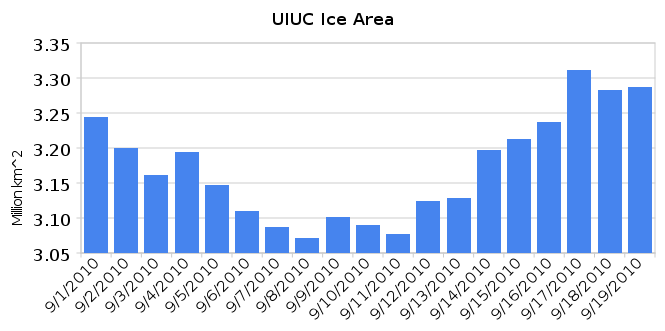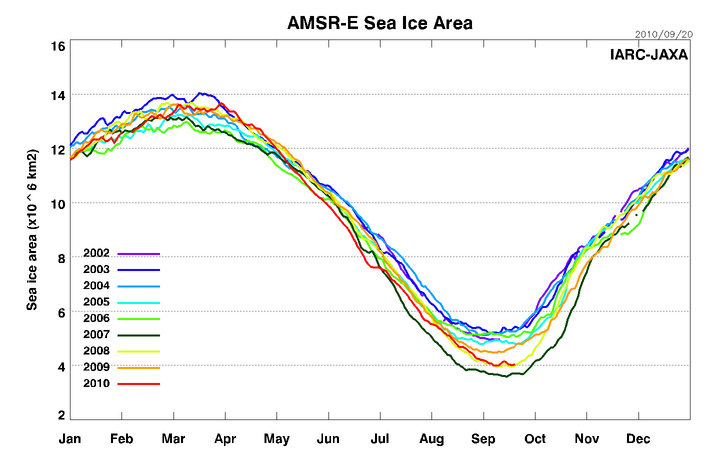http://arctic.atmos.uiuc.edu/cryosphere/timeseries.anom.1979-2008
Ice area is a better gauge (than extent) of the length of the melt season, because it is affected less by the wind blowing the ice edge around. As you can see, after September 8, formation of new ice became dominant in the Arctic. All of the area graphs show the same thing.
http://www.ijis.iarc.uaf.edu/seaice/extent/AMSRE_Sea_Ice_Area.png
 http://arctic-roos.org/observations/satellite-data/sea-ice/observation_images/ssmi1_ice_area.png
http://arctic-roos.org/observations/satellite-data/sea-ice/observation_images/ssmi1_ice_area.png
Joe Romm pictures the Arctic melting at -20ºC, but that only occurs in the world of global climate disruption.
http://psc.apl.washington.edu/northpole/POPS13_atmos_recent.html
09/20/1800Z 83.575°N 3.497°E -16.2°C 1010.8mb 09/20/1700Z 83.577°N 3.494°E -16.1°C 1011.5mb 09/20/1300Z 83.582°N 3.478°E -15.2°C 1010.1mb 09/20/1200Z 83.584°N 3.469°E -14.9°C 1009.6mb 09/20/1100Z 83.585°N 3.459°E -15.7°C 1009.3mb 09/20/1000Z 83.586°N 3.447°E -16.6°C 1009.5mb 09/20/0900Z 83.588°N 3.437°E -17.1°C 1009.1mb 09/20/0800Z 83.589°N 3.428°E -17.6°C 1008.8mb 09/20/0300Z 83.603°N 3.431°E -20.1°C 1007.0mb 09/20/0200Z 83.608°N 3.432°E -21.9°C 1007.3mb 09/20/0100Z 83.613°N 3.429°E -19.5°C 1008.0mb 09/20/0000Z 83.618°N 3.420°E -17.5°C 1009.2mb 09/19/2300Z 83.623°N 3.409°E -15.0°C 1009.7mb




I wonder why R. Gates has disappeared?
Of course the Alarmists are whinging on about “proof that the death spiral continues” with 2010 levels back at 2008 thresholds. However, the picture on ice volume is different but it is hard to get good data on this. Your PIPS analysis was the only item I was aware of that gave any indication of what has been going on in that respect. Is there any other sources of information on this out there?
I did an analysis of NSIDC ice age in this post
http://stevengoddard.wordpress.com/2010/09/12/september-12-2010-sea-ice-news/
September 9, 2010: Arctic Ice in Death Spiral
“I stand by my previous statements that the Arctic summer sea ice cover is in a death spiral. It’s not going to recover,” Mark Serreze
http://ipsnews.net/news.asp?idnews=52896
Yes, Arctic sea ice appeared to stop melting a week or so ago, but extent dropped again a few days after in nearly all the records. Just goes to show that weather plays a part in extent.
The IJIS graph shows area tracking near 2008 for most of September, and Cryosphere today nearly reached the 2008 low. If sea ice area is the new best metric, sea ice ‘recovery’ has been less than that shown by extent. This year’s September average will fall below the linear trend line for extent (and area), but within the next few years we should see a September average that falls above it.
Ice volume and age are the best metrics of “recovery.” There should be a significant increase in the amount of multi-year ice next spring, relative to the last two years.
Julienne Stroeve wrote this last week.
All of the 3rd year ice which survives the winter will be 4th year ice in the spring.
Why?
NSIDC has always gauged the health of Arctic ice based on the amount of multi-year ice. It is thicker, solider, and harder to melt.
Looking at the graphs, it is clear that the changes each year are within the normal bounds of variability.
This year we had slightly more ice during the winter + spring, and slightly less in summer. If you take the average for the year, it is, well, pretty average!
It is clear that based on this small sample there is no trend at all.
Aye, I know that. I meant, “why will there be more multi-year ice relative to the last two Springs?”
Between PIPS and PIOMAS, it’s rather difficult to say at the moment. CRYOSAT 2 might give us a better fix on the current state of the ice, but it will be a new standard and difficult, if not impossible to apply retrospectively.
Personally, I’d be wary of making predictions. I underestimated this year’s melt, too.
What is not average is the rate of melt, suggesting thinner ice, other factors considered.
That’s the pitfall of working with too-small samples. They don’t tell you much, if anything at all.
Wasn’t the whining last year about “multi-year” ice, (3 yrs and older)? Now it’s 4 years, and I assume we can write next years press release right now about the lack of 5 year ice.
The whole discussion about multi-year ice and rotten ice, and rapid melt, etc. reminds me of something that really bothers me about this subject that none of the experts talk about. The Arctic is such a dynamic place that 5 year old ice is old. The way the death spiral people talk there is this big chunk of ice up there that is as old as time and because of my car it is all melting away. The fact that there is not ice at the pole that is thousands of years old should indicate the system is highly variable and not driven by temperature. Ice gets flushed out into warmer water and melts, ocean water freezes in the winter and the whole process repeats itself annually with variations based on current and weather patterns. Making sweeping assumptions about global temperature from 30 years of data is irresponsible.
Where is all the pre-industial age sea ice in the arctic?